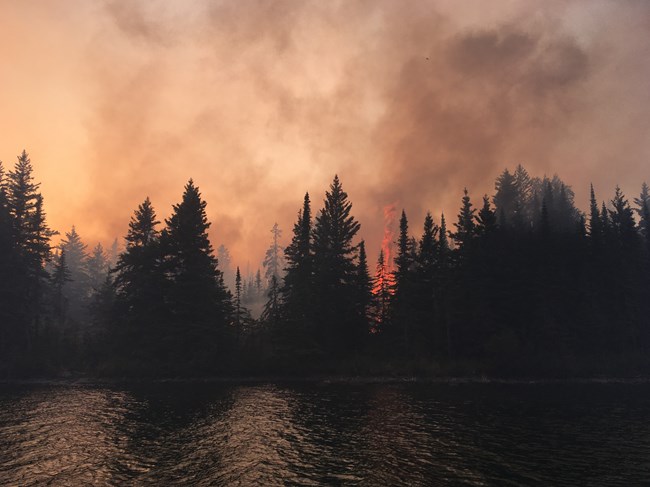Last updated: September 13, 2023
Article
Isle Royale Fire History

NPS
Fire on Isle Royale
Fire is a dynamic force that has shaped Isle Royale's landscape through time. Since park establishment and subsequent record keeping began, an average of two fires have been reported per year. Most of these fires are small in size - Lake Superior, inland lakes, wet areas, and rock outcroppings provide many effective natural barriers to spread. Others have grown to thousands of acres, changing the course of natural and human history on the island.

NPS
Early Fire History
People, land, and fire have interacted with each other for a long time. In the Great Lakes region, Indigenous peoples have used fire intentionally for thousands of years to manage ecosystems. Known as cultural burning, these small, controlled fires were used to provide a desired cultural service, such as the promotion of species diveristy and abundance for food, or the cultivation of natural resources for tools, clothing, ceremonial items, and more.
Although early fire history information on Isle Royale is limited, historical evidence shows people have visited the island as early as 2500 BC to fish, mine for copper, and take advantage of other natural resources. Sediment cores show layers of charcoal indicating periodic fires in the pre-settlement era, possibly supporting the use of cultural burns on Isle Royale. However, it remains unknown whether these fires were human caused, lightning caused, or a mix of both.

National Visual Inventory Cards 30-011
Fire Through Time
1800s
Official fire record keeping began in 1847, when the first General Land Office survey of Isle Royale was conducted. These records show 31 fires between 1847 and 1898. Data suggests fire was more frequent and/or severe in the boreal forest of the island's northeast end, compared to the northern hardwoods of the southwest end. Research also indicates incidence of fire on Isle Royale during the post-settlement era was greater than it would've been from natural consequence of lightning.
In the 1840s, industrial mining was introduced to Isle Royale, which could be a factor in the increased incidence of fire during this time period. One common way to locate copper deposits was to burn forests, exposing surface rock. After the mining boom ended in the late 1890s, incidence of fire decreased.
1900s
After industrial mining fizzled out, the incidence of fire decreased. The majority of fires on Isle Royale are small (less than one acre), but two major fires in the 1900s deserve particular mention: the Fire of 1936, and the Fire of 1948.
In 1948, fire broke out on Isle Royale following a lightning strike southeast of Lake Desor. This fire burned approximately 1,440 acres in an area previously burned by the Fire of 1936.
Fire Record
| Date | Location | Size in Acres | Ignition Source | Note |
|---|

Mike Ausema
Recent Fires
Despite its isolation, Isle Royale is not immune to elevated fire conditions. Climate events like drought increase fire risk, and negatively impact forest health. Drought and declining forest health were factors in both the 2021 Horne Fire and the 2022 Mount Franklin Fire.
On August 10, 2021, lightning struck Isle Royale several times during a major storm event. These lightning strikes resulted in multipe small fires on the island's northeastern end. The most signifact of these fires ignited near the Duncan Bay/Tobin Harbor Portage Trail. Initially, this small fire burned with a low flame and spread slowly. But on August 22, 2021, the fire expanded significantly when strong west winds pushed it up and over the Greenstone Ridge. The Horne Fire would go on to burn 335 acres.
